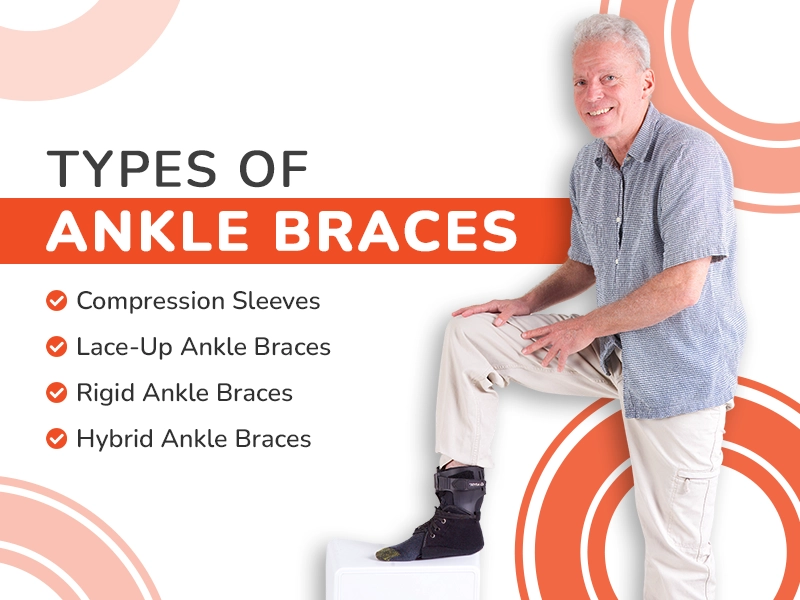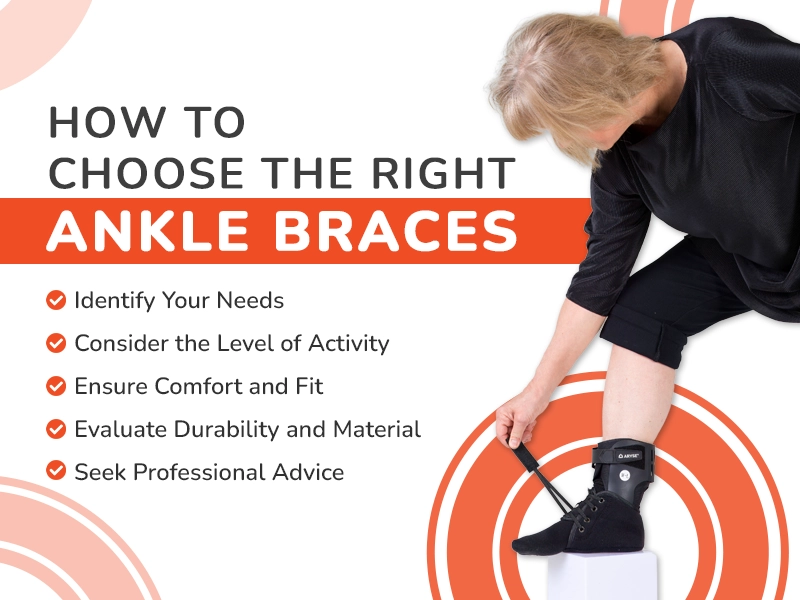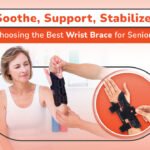Introduction
For athletes and active individuals, ankle injuries can be a major setback, disrupting training, competition, and overall fitness goals. Whether you’re into running, basketball, soccer, or hiking, ankle injuries are common in physically demanding activities. An ankle sprain, strain, or even a minor twist can significantly impact your performance, and in some cases, it can take weeks or even months to recover fully. This is why having the right ankle brace can make a world of difference in both preventing injury and providing support during recovery.
Ankle braces are not one-size-fits-all; they come in various forms to cater to different types of injuries and levels of activity. Some are designed for mild support, while others offer rigid stabilization for serious injuries. Choosing the right brace is key to staying active, recovering quickly, and avoiding further complications. In this guide, we’ll explore the different types of ankle braces, how they work, and which one is best suited for your specific needs as an athlete or an active individual.
Why Ankle Braces Matter for Athletes
Athletes are particularly prone to ankle injuries due to the dynamic movements required in sports. From sprinting to jumping, pivoting, and quick lateral movements, the ankle joint is constantly under stress. Sports like basketball, soccer, tennis, and football are especially risky due to the fast changes in direction and high-impact landings. According to sports medicine experts, ankle sprains are one of the most common injuries among athletes, often occurring when the foot rolls inward or outward, overstretching the ligaments.
Ankle braces provide essential support by stabilizing the ankle joint, limiting the range of motion, and protecting the ligaments from further injury. Whether you’re recovering from an injury or looking to prevent one, wearing an ankle brace can help you feel more secure, confident, and capable during training and competition.
Ankle braces are also valuable for athletes with chronic ankle instability, a condition where the ankle frequently rolls or gives way, often after repeated sprains. By providing consistent support, ankle braces can reduce the risk of re-injury and allow athletes to continue participating in their sport.
Types of Ankle Braces
There are several types of ankle braces available, each designed to offer different levels of support, mobility, and comfort. Understanding the differences between them is crucial to choosing the right one for your activity level and injury needs. Let’s dive into the most common types of ankle braces:

1. Compression Sleeves
Compression sleeves are lightweight, flexible braces that provide mild support and compression to the ankle. They work by applying gentle pressure to the area, which helps reduce swelling, improve circulation, and promote faster recovery from minor injuries. Compression sleeves are ideal for athletes who are recovering from mild sprains or who want to add a bit of extra support during lower-impact activities.
Best For
- Minor ankle sprains or strains
- Reducing swelling and inflammation
- Low-impact activities such as walking, yoga, or Pilates
Pros
- Lightweight and easy to wear
- It offers a full range of motion, making it suitable for activities requiring flexibility
- It can be worn comfortably with athletic shoes
Cons
- It provides minimal stabilization, so it may not be suitable for more severe injuries or high-intensity sports
- It may not offer enough support for athletes with chronic ankle instability
2. Lace-Up Ankle Braces
Lace-up ankle braces provide moderate support and are often used by athletes recovering from ankle sprains or those who experience chronic instability. These braces feature adjustable laces, similar to a shoe, that allow for a customized fit and level of compression. Lace-up braces limit some movement in the ankle, providing a balance between support and flexibility, making them a popular choice among athletes in sports like basketball, football, and soccer.
Best For
- Recovery from moderate ankle sprains or strains
- Athletes with chronic ankle instability
- High-impact sports such as basketball, football, soccer, or volleyball
Pros
- Customizable fit due to the laces, allowing you to adjust the brace to your comfort level
- Provides moderate support without being overly restrictive
- Suitable for a wide range of sports where lateral movement and jumping are common
Cons
- It can be more restrictive than compression sleeves, limiting mobility in some cases
- It may not fit comfortably with all types of athletic shoes, especially if worn for extended periods
- It requires more effort to put on and take off compared to slip-on braces
3. Rigid Ankle Braces
Rigid ankle braces offer the highest level of support and are often used by athletes recovering from more serious ankle injuries, such as severe sprains or fractures. These braces typically have hard plastic or metal components that restrict ankle movement, preventing further injury during the healing process. Rigid braces are also used after surgery to immobilize the joint and protect the ligaments and tendons while they heal.
Best For
- Severe ankle sprains or fractures
- Post-surgical recovery and rehabilitation
- High-risk activities or sports that involve intense movement, such as gymnastics or martial arts
Pros
- It provides the highest level of stability and protection for the ankle joint
- Prevents excessive movement, reducing the risk of re-injury
- It is ideal for injury recovery, allowing for proper healing without stressing the joint
Cons
- Significantly limits mobility, making it less ideal for active sports that require a wide range of motion
- Bulky and may be uncomfortable for extended wear or during high-intensity activity
- May not fit inside all athletic shoes, requiring specialized footwear during recovery
4. Hybrid Ankle Braces
Hybrid braces combine the best features of both lace-up and rigid braces, offering a balance between flexibility and support. These braces typically feature a lace-up design with semi-rigid side supports, allowing athletes to move more freely while still providing adequate stabilization. Hybrid braces are a good option for athletes who need more than just mild support but don’t want the restrictive feel of a fully rigid brace.
Best For
- Athletes with moderate ankle instability or recurring sprains
- Preventing reinjury during sports and physical activities
- High-impact activities that require a mix of stability and flexibility, such as tennis, running, and hiking
Pros
- It offers a combination of support and mobility, making it suitable for a wide range of sports and activities
- Customizable fit with adjustable laces or straps
- Provides enough support to prevent reinjury without completely restricting movement
Cons
- It may be too restrictive for athletes who need full mobility for their sport
- Bulkier than compression sleeves, making it harder to wear with certain types of shoes
How to Choose the Right Ankle Brace
Choosing the right ankle brace requires careful consideration of your activity level, the type of injury you’re dealing with, and the amount of support you need. Here’s a step-by-step guide to help you make the best decision:

1. Identify Your Needs
Before selecting an ankle brace, assess your specific needs. Are you recovering from an injury or trying to prevent one? Do you have chronic ankle instability or a history of ankle sprains? Understanding your needs will help narrow down your options.
- For Injury Prevention: If you’re an athlete looking to prevent injuries during sports, a lace-up brace or compression sleeve may provide the necessary support without being too restrictive.
- For Recovery: If you’re recovering from a severe sprain, fracture, or surgery, consider a rigid brace that offers maximum support to prevent further damage.
2. Consider the Level of Activity
The type of sport or physical activity you engage in should play a significant role in choosing an ankle brace. High-impact and lateral-motion sports like basketball, soccer, and football require more support to protect the ankle from sudden twists or turns. For these sports, a lace-up or hybrid brace may be ideal. If you’re involved in lower-impact activities like running or hiking, a compression sleeve might provide sufficient support without restricting movement.
3. Ensure Comfort and Fit
Comfort is crucial when choosing an ankle brace, especially if you plan to wear it during extended periods of activity. Look for braces made from breathable materials like neoprene or nylon, which provide comfort and flexibility. You should also ensure that the brace fits well with your athletic shoes and doesn’t cause any discomfort while moving.
- Tip: Always try on the brace with your athletic shoes to ensure a proper fit before purchasing. This will help avoid any issues during sports or exercise.
4. Evaluate Durability and Material
The durability of the ankle brace is another important factor, especially for athletes involved in high-intensity sports. Braces made from high-quality, durable materials will last longer and provide consistent support over time. Neoprene braces are flexible and durable, while rigid braces are made from materials like plastic or metal, which offer long-lasting stability.
Read More: Understanding Ankle Braces: Uses, Benefits, and Types
5. Seek Professional Advice
If you’re unsure which ankle brace is best for your specific condition or sport, it’s always a good idea to consult with a healthcare professional. A physical therapist or sports medicine specialist can evaluate your injury or stability needs and recommend the most appropriate brace for your situation.
Conclusion
Choosing the right ankle brace is essential for athletes and active individuals who want to protect their ankles from injury or support recovery. Whether you need a compression sleeve for mild support, a lace-up brace for moderate stability, or a rigid brace for serious injury recovery, there are options available to meet every need.
By considering your activity level, injury type, and comfort preferences, you can find an ankle brace that provides the support you need to stay active and injury-free. Remember, the right ankle brace can enhance your performance, boost your confidence, and help you get back to doing what you love with less worry about potential injuries.




